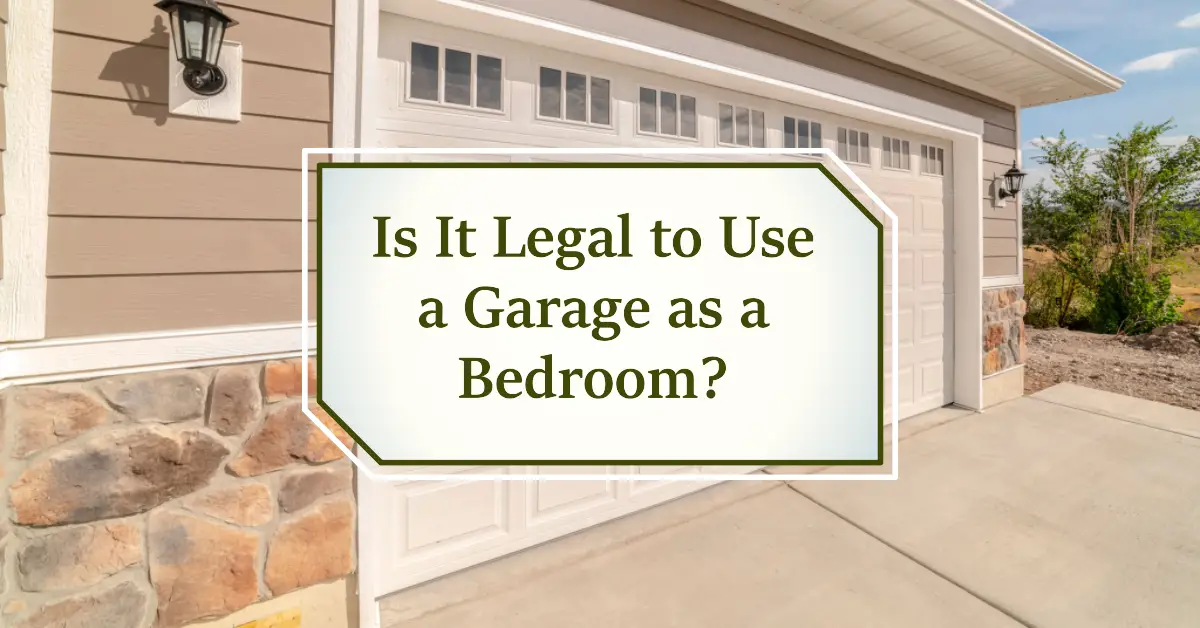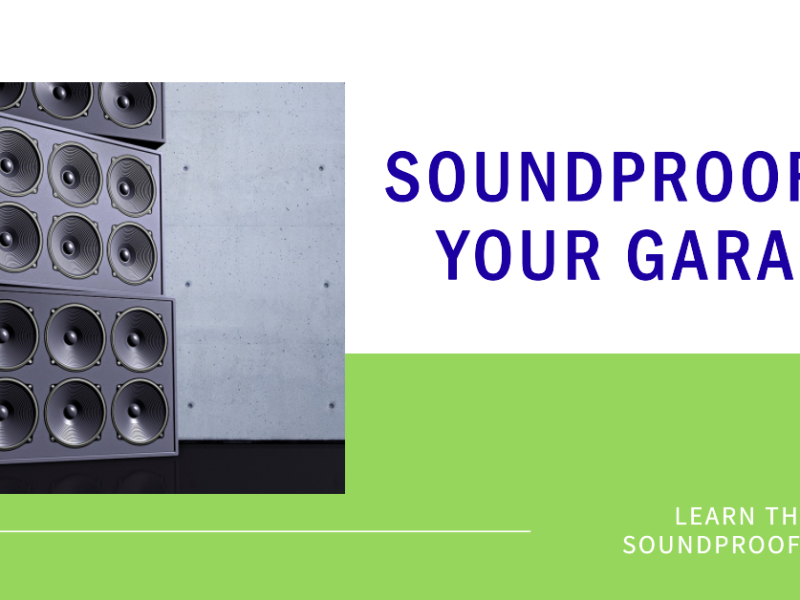I am a well-rounded expert with proficiency in several fields. My experience spans from being a dedicated chef and homemaker. As a passionate homesteader, I’ve honed my skills in sustainable living and animal care, ensuring a holistic approach to everything I undertake. Email me or Txt: (# removed due to spam, please email)
The garage conversion trend has gained significant traction, as homeowners seek to create additional living space without the expense and hassle of constructing an entirely new room.
However, converting a garage into a bedroom raises legal concerns and requires understanding local and state laws.
This comprehensive guide will explore the legalities, requirements, and best practices for converting a garage into a bedroom.

Understanding Local and State Laws
Garage conversions can be an excellent way to add living space to your home, but before starting any construction, it is crucial to familiarize yourself with the relevant zoning regulations, building codes, permits, and inspections that govern residential properties in your area.
Zoning laws dictate how land can be used and often set limits on the number of bedrooms, bathrooms, and overall square footage allowed in a residential property.
There may also be restrictions on using unfinished spaces, such as a garage, as a bedroom.
It is essential to research your local zoning laws to ensure your garage conversion project complies with these requirements.
Building codes ensure the safety and health of occupants and cover various aspects of construction, including structural integrity, electrical and plumbing systems, and fire safety.
It is crucial to ensure that your garage conversion project meets these requirements by consulting your local building department and obtaining necessary permits.
In addition to zoning regulations and building codes, other factors to consider when planning a garage conversion project include parking requirements, setbacks, and historic preservation requirements.
Consulting with professionals, such as architects or contractors, can help ensure that your garage conversion project complies with local and state laws and regulations.
It is also essential to schedule necessary inspections during the construction process to ensure that the work is up to code.
Understanding local and state laws and regulations is crucial when planning a garage conversion project. Familiarizing yourself with zoning regulations, building codes, permits, and inspections will help ensure that your project complies with these requirements and is safe for occupants.
Consulting with professionals and scheduling necessary inspections can also help ensure a successful and compliant garage conversion project.

Defining a “Finished” Garage
A garage is considered “finished” when it meets the following criteria:
- Structural requirements: Adequate support and load-bearing capacity, properly installed foundation, and compliance with local and state building codes.
- Insulation and ventilation: Proper insulation and ventilation to maintain comfortable temperatures and prevent condensation.
- Electrical and plumbing systems: Updated and code-compliant electrical and plumbing installations. (if exist)
- Fire safety measures: Installed smoke detectors, fire-rated doors, and egress windows for emergency exits.
- Windows and emergency exits: Sufficient natural light and accessible escape routes.

The Conversion Process
Converting a garage into living space can be an exciting project, but it requires careful planning and consideration of various factors. Here are some steps to follow when planning your garage conversion:
- Assess the feasibility of the project: The first step in converting your garage is to assess the feasibility of the project. Consider factors such as available space, budget, and long-term plans for your home. Determine if the garage is structurally sound and if it can be converted into a livable space.
- Hire professionals or opt for a DIY approach: Depending on your skills, resources, and desired outcomes, you can hire professionals or opt for a DIY approach. If you’re not experienced in construction work, it’s essential to hire professionals who can help you with the design, construction, and necessary permits.
- Obtain accurate cost estimates: Converting a garage can be costly, so it’s important to obtain accurate cost estimates from contractors and professionals. Be sure to factor in the cost of permits, materials, labor, and any unforeseen expenses that may arise.
- Establish a realistic timeline: Establishing a realistic timeline for your project is essential for planning and managing the construction process. Consider factors such as the scope of the project, availability of materials, and the time required for inspections and permits.
- Plan the design and layout: Once you’ve assessed the feasibility of the project, hired professionals, obtained cost estimates, and established a timeline, it’s time to plan the design and layout of your new living space. Consider factors such as lighting, flooring, plumbing, and electrical systems.

Designing the Garage Bedroom
When designing a garage bedroom, there are several essential considerations to keep in mind. Here are some tips for creating a functional and aesthetically pleasing living space:
- Space planning: Space planning is crucial for maximizing available space and creating a functional layout. Consider the size and shape of the room, the placement of doors and windows, and the location of electrical outlets and light switches. Sketching out a floor plan can help you visualize the space and plan your design accordingly.
- Layout: The layout of the garage bedroom should be functional and conducive to relaxation and rest. Consider the placement of the bed, wardrobe, and other furniture pieces. Opt for a layout that maximizes available space while providing adequate storage and seating options.
- Style: The style of the garage bedroom should reflect your personal taste and complement the rest of your home’s décor. Choose a style that is cohesive with the existing architectural features and overall design scheme.
- Lighting: Natural and artificial lighting sources are essential for creating a welcoming atmosphere in the garage bedroom. Incorporate natural light sources, such as windows or skylights, if possible, and choose appropriate artificial lighting fixtures to provide adequate task and ambient lighting.
- Flooring: The choice of flooring material is essential for both durability and comfort. Opt for flooring materials that are durable and easy to clean, such as hardwood, laminate, or tile. Consider adding area rugs or carpeting for added warmth and comfort.
Designing a garage bedroom requires careful consideration of space planning, layout, style, lighting, and flooring.
By optimizing available space, creating a functional and relaxing layout, choosing appropriate lighting and flooring materials, and reflecting your personal style, you can create a beautiful and comfortable living space.

Essential Amenities for a Garage Bedroom
If you’re planning to convert your garage into a bedroom, there are several essential amenities that you may want to consider. These include:
- Storage solutions: Adequate storage is essential for a functional and clutter-free living space. Consider incorporating built-in storage solutions, such as wardrobes and shelving, to maximize available space.
- Bathroom facilities: Depending on the location of your garage, you may want to consider adding bathroom facilities to your bedroom. This can include a toilet, sink, and shower or bathtub. If adding a bathroom is not feasible, consider creating a designated area for a portable toilet and sink.
- Kitchenette: A kitchenette can provide added convenience for preparing meals and snacks. This can include a mini-fridge, microwave, sink, and countertop space for food preparation. Adding a small dining area can also be a nice touch.
- Entertainment options: Adding entertainment options, such as a television, stereo system, or gaming console, can help make the garage bedroom feel more like a comfortable and welcoming living space.
Integrating storage solutions, bathroom facilities, a kitchenette, and entertainment options can transform your garage bedroom into a fully functional living space. By prioritizing these amenities, you can create a comfortable and convenient living space that meets your needs and preferences.

Safety and Security Measures for a Garage Bedroom:
When converting your garage into a bedroom, it’s important to prioritize safety and security measures to protect occupants and comply with safety regulations. Here are some essential measures to consider:
- Smoke and carbon monoxide detectors: Install smoke and carbon monoxide detectors in the garage bedroom to detect any potential fire or gas hazards. Test the detectors regularly to ensure they are functioning properly.
- Fire extinguishers: Keep a fire extinguisher in the garage bedroom to help extinguish any potential fires. Ensure that the extinguisher is accessible and that occupants know how to use it.
- Escape plans: Develop an escape plan in case of an emergency. Ensure that all occupants know the plan and the location of exits and emergency equipment, such as fire extinguishers.
- Security systems: Install a security system in the garage bedroom to protect against burglary and break-ins. This can include a security camera, motion detectors, and an alarm system.
- Lockable garage door: If your garage has a garage door, make sure it can lock solidly to prevent unauthorized entry. If the door is not secure, consider upgrading the locking mechanism or installing an additional lock.
Energy Efficiency and Sustainability
Incorporate energy-efficient appliances, insulation, and renewable energy options, such as solar panels, to minimize your ecological footprint and reduce utility costs.

Legalizing an Existing Garage Conversion
If you have an existing garage conversion that does not meet local and state requirements, it’s important to take the necessary steps to legalize the conversion. Here are some essential steps to consider:
- Consult an architect or engineer: Consult an architect or engineer to assess the existing conversion and identify any code violations. They can help you understand the necessary improvements required to meet local and state requirements.
- Obtain the necessary permits: Once you have identified the necessary improvements, obtain the necessary permits from your local building department. This may include building permits, electrical permits, plumbing permits, and other necessary permits.
- Pay any fines or penalties: If there are any outstanding fines or penalties associated with the existing conversion, pay them promptly to avoid further legal complications.
- Make the necessary improvements: Once you have obtained the necessary permits and paid any fines or penalties, make the necessary improvements to the conversion to comply with local and state requirements. This may include structural improvements, electrical upgrades, and plumbing upgrades.
- Schedule inspections: Schedule inspections with your local building department to ensure that the improvements meet local and state requirements. This may include inspections for structural, electrical, and plumbing systems.
Legalizing an existing garage conversion requires consultation with an architect or engineer to identify code violations, obtaining the necessary permits, paying any fines or penalties, making the necessary improvements, and scheduling inspections to ensure compliance with local and state requirements.
By following these essential steps, you can legalize your conversion and enjoy your living space with peace of mind.

Pros and Cons of Converting a Garage
Converting a garage into living space can provide many benefits, but it’s important to weigh these benefits against potential challenges. Here are some pros and cons to consider when converting a garage:
Pros:
- Increased living space: Converting a garage can provide additional living space for a growing family, elderly relatives, or guests.
- Potential return on investment: A garage conversion can increase the value of your home and provide a potential return on investment if you choose to sell your property in the future.
- Cost savings: A garage conversion can be a cost-effective way to create additional living space compared to building a new addition.
- Versatility: The converted garage can be used for a variety of purposes, including a home office, studio, gym, or rental unit.
Cons:
- Reduced storage space: Converting a garage can reduce available storage space for vehicles, tools, and other items.
- Permit issues: Depending on local zoning regulations and building codes, obtaining the necessary permits for a garage conversion can be a complex and time-consuming process.
- Potential impact on property value: While a garage conversion can increase property value, it can also have a negative impact if the conversion is poorly executed or not suited to the needs of potential buyers.
- Design limitations: The existing garage structure may have design limitations that can impact the layout and functionality of the converted space.
Converting a garage can provide many benefits, including increased living space, potential return on investment, and cost savings.
It’s also important to consider potential challenges, such as reduced storage space, permit issues, potential impact on property value, and design limitations.

Alternatives to a Garage Bedroom
If a garage conversion is not feasible or desirable, there are other options for creating additional living space. Here are some alternatives to consider:
- Attic or basement conversions: Converting an attic or basement into living space can provide additional square footage and increase the value of your home. This option may be more cost-effective than building an addition or converting a garage.
- Home additions: Building a home addition can provide additional living space tailored to your specific needs and preferences. This option can be more expensive than a garage conversion, but it offers more flexibility in terms of design and layout.
- Detached living spaces: Building a detached living space, such as a guesthouse or studio, can provide additional living space while maintaining the privacy and functionality of your garage.

Insurance and Tax Implications
When converting a garage into a bedroom, it’s important to consider the insurance and tax implications. Here are some factors to keep in mind:
- Homeowners insurance: You may need to update your homeowners insurance policy to reflect the change in use of the garage. Check with your insurance provider to ensure that your coverage remains adequate and to identify any necessary changes to your policy.
- Property taxes: Converting a garage into a bedroom can impact your property taxes. Check with your local assessor’s office to determine the potential impact on your property taxes.
- Resale value: While a garage conversion can increase the value of your home, it’s important to consider the potential impact on resale value. If the conversion is poorly executed or not suited to the needs of potential buyers, it could have a negative impact on resale value.
- Permits and compliance: Failure to comply with local zoning regulations and building codes can also impact your insurance and tax obligations. Ensure that you obtain the necessary permits and comply with all relevant regulations to avoid potential legal and financial issues.

Common Mistakes and How to Avoid Them
When converting a garage into living space, it’s important to avoid common mistakes that can compromise the safety, functionality, and legal compliance of the project. Here are some mistakes to avoid and tips on how to do so:
- Overlooking permits and inspections: Failure to obtain the necessary permits and inspections can result in costly fines and legal issues. Conduct thorough research to identify the permits and inspections required in your area, and comply with all relevant regulations.
- Skimping on insulation and ventilation: Poor insulation and ventilation can result in uncomfortable living conditions, moisture damage, and mold growth. Invest in quality insulation and ventilation systems to ensure a comfortable, healthy, and energy-efficient living space.
- Neglecting safety and security measures: Safety and security measures, such as smoke detectors, carbon monoxide detectors, fire extinguishers, and security systems, are essential to protect occupants and comply with safety regulations. Don’t neglect these critical elements of a safe and functional living space.
- Failing to plan for storage: Neglecting to plan for adequate storage can result in cluttered and disorganized living spaces. Incorporate creative and efficient storage solutions into your garage conversion design to maximize available space and enhance the functionality of the room.
- Ignoring the impact on property value: While a garage conversion can increase the value of your home, it’s important to consider the potential impact on resale value. Ensure that the conversion is well-executed and suited to the needs of potential buyers to avoid potential negative impacts on property value.

Conclusion
Converting a garage into a bedroom is a viable option for homeowners seeking additional living space, provided they comply with local and state regulations and follow best practices. By carefully considering the pros and cons, assessing the feasibility of the project, and planning for safety, comfort, and functionality, you can create a legally compliant and valuable garage bedroom.



